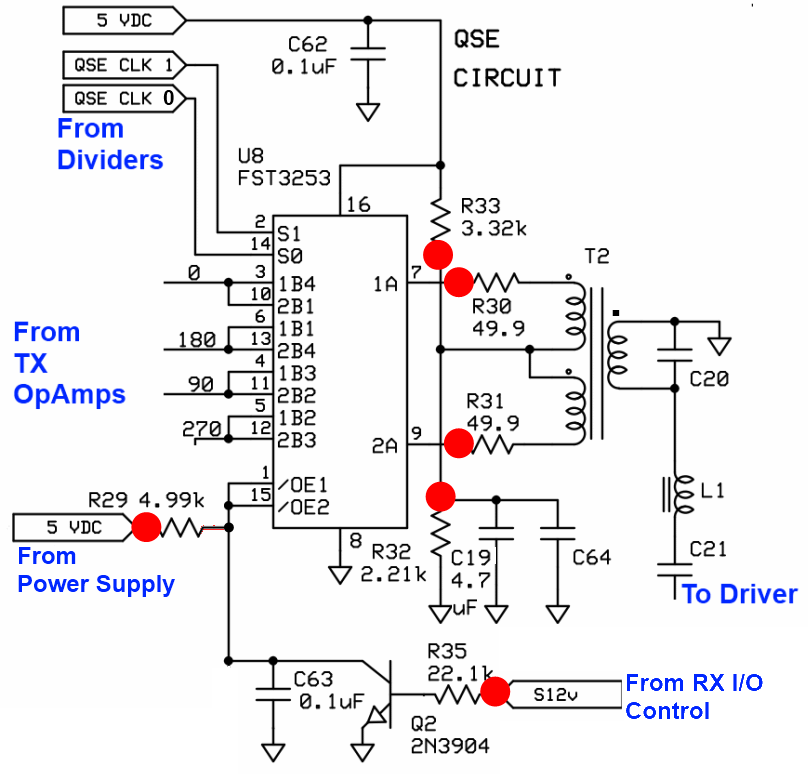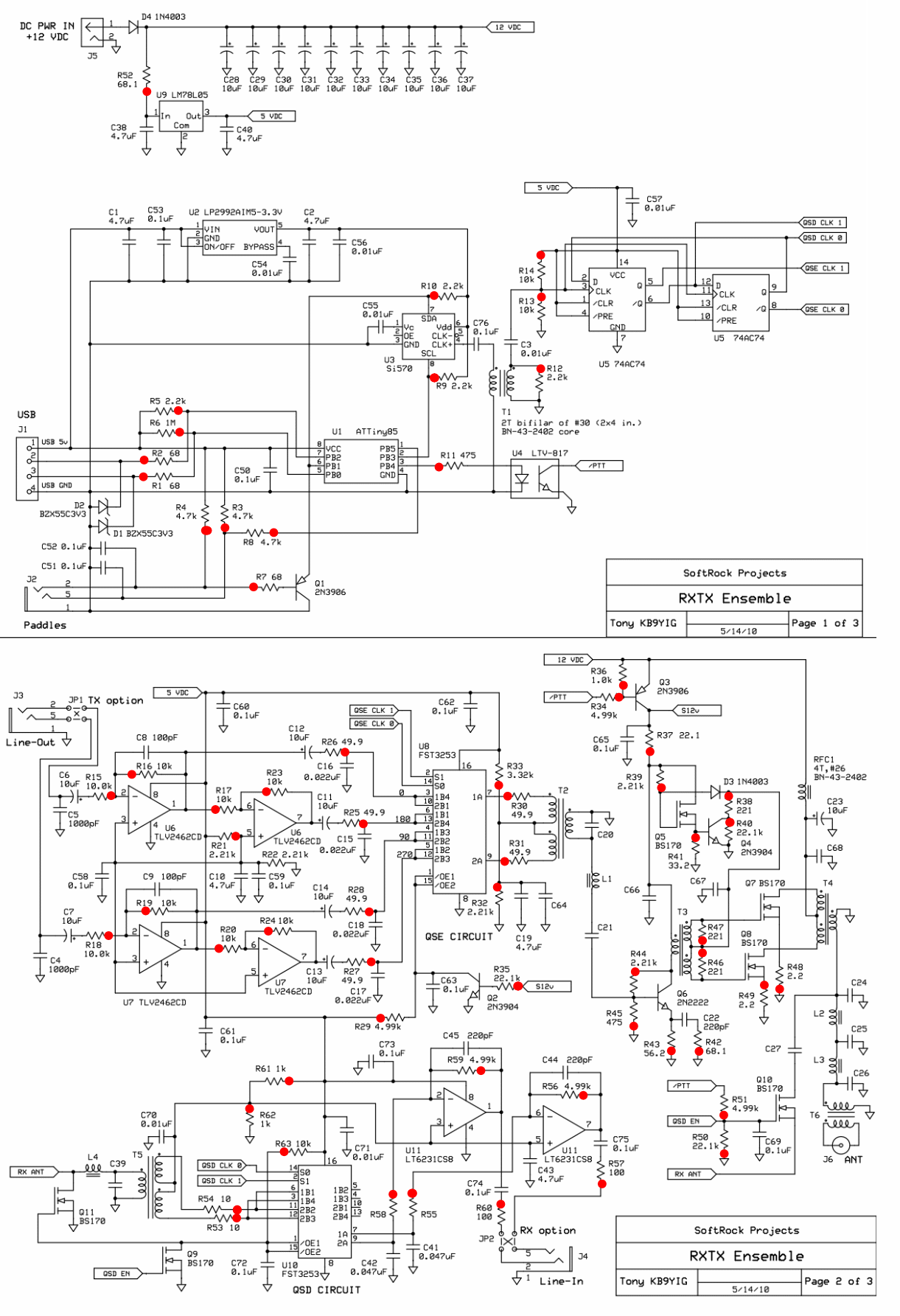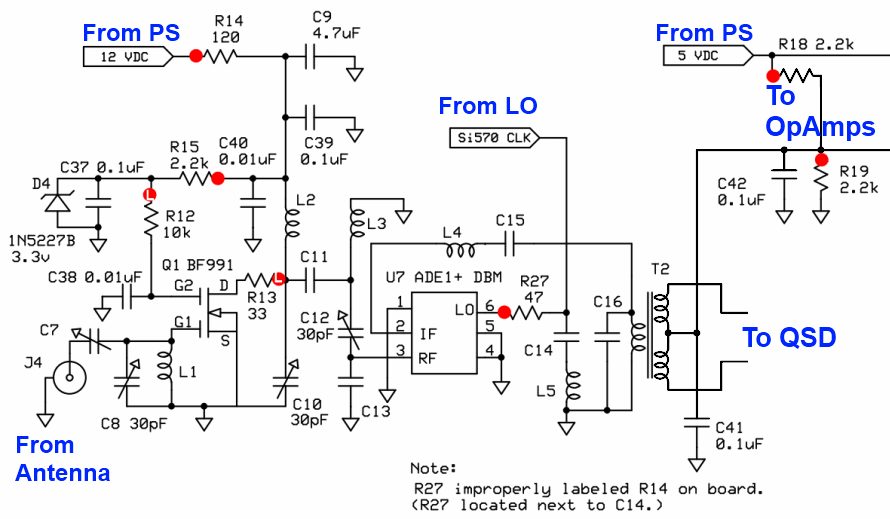
Ensemble RX Builders

This kit is the earlier, now retired Ensemble RX version. These instructions are provided for those who possess and might have delayed building that version of the Ensemble RX kit. The latest version is the Ensemble RX II kit. The Ensemble RX kit and its 4.5 x 2-inch board represent the culmination of a long line of Softrock SDR receivers from Tony Parks, KB9YIG. The line began with the Softrock 40 RX and went through several iterations of receivers. The most recent receiver was the All-band receiver with an add-on automatically switched bandpass filter. This current kit is a considerable refinement on that kit and streamlines the kitting process for Tony. The Ensemble RX kit provides coverage of ham bands from 160-10m, in four different optional "super bands" (each with underlap and overlap within the parameters of the associated bandpass filter). The band coverage is via four switchable "bands" ("superbands"). Band switching is performed under program control, in conjunction with programmatic control of the receive frequency. This control is provided by an Atmel ATTiny85 microcontroller, acting as a USB device to control the Si570 programmable oscillator and automatically switch to the appropriate band (0-3) as the frequency changes. As a welcome improvement over other models, this kit provides PCB-right-angle jacks for all external connections: Antenna, USB from the PC, I/Q output to the PC, and Power to the board. Thus, once built, the kit can be placed in a suitable enclosure and handled thereafter as a "black box peripheral" to the PC. The design of the Ensemble RX is very similar to the receiver design of its sibling Ensemble RXTX. The major difference is the greater band coverage of the Ensemble RX kit (roughly four "superbands" on the RX vs. one "superband" on the RXTX). This kit is an excellent value for both the licensed amateur and the SWL who is comfortable with building electronics kits. The skill level and experience requirements are medium-level because of the small size of the components, the requirement to be able to solder SMT parts, and the requirement to wind and install inductors. Thousands of builders have proven this is not an insurmountable set of requirements. If new to this, it is recommended to try one of Tony's sub $20 monobander RX kits as a "starter/learner" kit. This receiver implements a quadrature sampling detector to produce low-frequency I and Q signals for input to the stereo line-in inputs of a PC sound card. The I and Q signals are the product of the quadrature sampling detector (QSD) stage, in which bandpass filtered "chunks" of RF are mixed with quadrature clock signals to produce the down-converted I and Q signals. These products (the I and Q pairs) are identical to each other in all respects except phase, where they are 90 degrees apart. The I/Q products of the QSD ("mixer"), when input to the appropriate SDR program through the PC's STEREO line-in sound card input, result in a spectrum display on the PC which will show signals arrayed around a "center frequency." This "center frequency" is the frequency of the I/Q outputs from the Quadrature Clock Generators. The bandwidth of the signals either side of the center frequency will be approximately equal to the sampling rate of the PC's sound card. Thus, if the local oscillator is tuned to produce 28.4 MHz to the Quadrature Clock Generators, they will output two signals (I and Q clocks) at 7.1 MHz (the "center frequency"). If the PC's sound card has a 48 kHz sampling rate, then the SDR program can translate the QSD's I/Q outputs into a chunk of spectrum that is 24 kHz either side of the center frequency of 7.1 MHz: i.e., 7.076 - 7.124 MHz. As the user tunes the receiver, varying the frequency of the local oscillator, the microcontroller tracks the frequency and switches the appropriate bandpass filter into the RF chain. The SDR program's display will update to show the new center frequency.
The Ensemble RX kit serves as an advanced software-defined radio (SDR) receiver, designed for amateur radio enthusiasts and shortwave listeners (SWLs). It is built on a compact printed circuit board (PCB) measuring 4.5 x 2 inches, integrating a range of features that enhance its usability and performance. The kit allows users to receive signals across amateur radio bands from 160 meters to 10 meters, segmented into four distinct "super bands." Each band can be selected programmatically, allowing for seamless frequency management and a user-friendly experience.
Central to the operation of the Ensemble RX is the Atmel ATTiny85 microcontroller, which interfaces with the Si570 programmable oscillator. This microcontroller facilitates automatic band switching as the user adjusts the frequency, ensuring optimal reception across the selected bands. The inclusion of right-angle jacks for connections—such as antenna input, USB interface, I/Q output, and power supply—simplifies physical integration and enhances the kit's modularity. This design choice allows the completed unit to function effectively as a "black box" peripheral, easily incorporated into existing PC setups.
The receiver employs a quadrature sampling detector (QSD) to generate in-phase (I) and quadrature (Q) signals, which are essential for digital signal processing. The QSD works by mixing filtered RF signals with quadrature clock signals, resulting in two output signals that are 90 degrees out of phase. These I/Q signals are then fed into the stereo line-in of a PC sound card, where specialized SDR software can visualize the spectrum of received signals, displaying them around a defined center frequency.
The performance of the Ensemble RX kit is further enhanced by the ability to track and filter signals accurately, allowing users to explore a wide range of frequencies with clarity. The kit's design and functionality make it suitable for users with medium-level electronics skills, particularly those familiar with soldering surface-mount technology (SMT) components and constructing inductors. The Ensemble RX kit represents a significant evolution in the Softrock SDR series, offering refined features and improved usability for both novice and experienced builders.This kit is the earlier, now retired Ensemble RX version. These instructions are provided for those who possess and might have delayed building that version of the Ensemble RX kit. The latest version is the Ensemble RX II. Kit. The Ensemble RX kit and its 4. 5: X 2" board represent the culmination of a long line of Softrock SDR receivers from Tony Parks, KB9YIG. The line began with the Softrock 40 RX and went through several iterations of receivers. The most recent receiver was the All-band receiver with an add-on automatically switched bandpass filter. This current kit is a considerable refinement on that kit and streamlines the kitting process for Tony.
The Ensemble RX kit provides coverage of ham bands from 160-10m, in four different optional "super bands" (each with underlap and overlap within the parameters of the associated bandpass filter): The band coverage is via 4 switchable "bands" ("superbands"). Band switching is performed under program control, in conjunction with programmatic control of the receive frequency.
This control is provided by an Atmel ATTiny85 micro-controller, acting as a USB device to control the Si570 programmable oscillator and automatically switch to the appropriate band (0-3) as the frequency changes. As a welcome improvement over other models, this kit provides pcb-right-angle jacks for all external connections: Antenna, USB from the PC, I/Q output to the PC, and Power to the Board.
Thus, once built, the kit can be placed in a suitable enclosure and handled thereafter as a "blackbox peripheral" to the PC. The design of the Ensemble RX is very similar to the receiver design of its sibling Ensemble RXTX. The major difference is the greater band coverage of the Ensemble RX kit (roughly 4 "superbands" on the RX vs.
1 "superband" on the RXTX). This kit is an excellent value for both the licensed amateur and the SWL who is comfortable with building electronics kits. The skill level and experience requirements are medium-level because of the small size of the components, the requirement to be able to solder SMT parts, and the requirement to wind and install inductors.
Thousands of builders have proven this is not an insurmountable set of requirements. If you are new at this, you should try one of Tony`s sub $20 monobander RX kits as a "starter/learner" kit. This receiver implements a quadrature sampling detector to produce low frequency I and Q signals for input to the stereo line in inputs of a PC sound card.
The I and Q signals are the product of the quadrature sampling detector (QSD) stage, in which bandpass filtered "chunks" of RF are mixed with quadrature clock signals to produce the down-converted I and Q signals. These products (the I and Q pairs) are identical to each other in all respects except phase, where they are 90 degrees apart.
The I/Q products of the QSD ("mixer"), when input to the appropriate SDR program through the PC`s STEREO line-in soundcard input, result in a spectrum display on the PC which will show signals arrayed around a "center frequency". This "center frequency" is the frequency of the I/Q outputs from the Quadrature Clock Generators. The bandwidth of the signals either side of the center frequency will be approximately equal to the sampling rate of the PC`s sound card.
Thus, if the local oscillator is tuned to produce 28. 4 MHz to the Quadrature Clock Generators, they will output two signals (I and Q clocks) at 7. 1MHz (the "center frequency"). If the PC`s sound card has a 48 kHz sampling rate, then the SDR program can translate the QSD`s I/Q outputs into a chunk of spectrum that is 24 kHz either side of the center frequency of 7. 1 MHz: i. e, 7. 076 - 7. 124 MHz. As the user tunes the receiver, varying the frequency of the local oscillator, the micro-controller tracks the frequency and switches the appropriate bandpass filter into the RF chain.
The SDR program`s display will update to show the new center f 🔗 External reference
The Ensemble RX kit serves as an advanced software-defined radio (SDR) receiver, designed for amateur radio enthusiasts and shortwave listeners (SWLs). It is built on a compact printed circuit board (PCB) measuring 4.5 x 2 inches, integrating a range of features that enhance its usability and performance. The kit allows users to receive signals across amateur radio bands from 160 meters to 10 meters, segmented into four distinct "super bands." Each band can be selected programmatically, allowing for seamless frequency management and a user-friendly experience.
Central to the operation of the Ensemble RX is the Atmel ATTiny85 microcontroller, which interfaces with the Si570 programmable oscillator. This microcontroller facilitates automatic band switching as the user adjusts the frequency, ensuring optimal reception across the selected bands. The inclusion of right-angle jacks for connections—such as antenna input, USB interface, I/Q output, and power supply—simplifies physical integration and enhances the kit's modularity. This design choice allows the completed unit to function effectively as a "black box" peripheral, easily incorporated into existing PC setups.
The receiver employs a quadrature sampling detector (QSD) to generate in-phase (I) and quadrature (Q) signals, which are essential for digital signal processing. The QSD works by mixing filtered RF signals with quadrature clock signals, resulting in two output signals that are 90 degrees out of phase. These I/Q signals are then fed into the stereo line-in of a PC sound card, where specialized SDR software can visualize the spectrum of received signals, displaying them around a defined center frequency.
The performance of the Ensemble RX kit is further enhanced by the ability to track and filter signals accurately, allowing users to explore a wide range of frequencies with clarity. The kit's design and functionality make it suitable for users with medium-level electronics skills, particularly those familiar with soldering surface-mount technology (SMT) components and constructing inductors. The Ensemble RX kit represents a significant evolution in the Softrock SDR series, offering refined features and improved usability for both novice and experienced builders.This kit is the earlier, now retired Ensemble RX version. These instructions are provided for those who possess and might have delayed building that version of the Ensemble RX kit. The latest version is the Ensemble RX II. Kit. The Ensemble RX kit and its 4. 5: X 2" board represent the culmination of a long line of Softrock SDR receivers from Tony Parks, KB9YIG. The line began with the Softrock 40 RX and went through several iterations of receivers. The most recent receiver was the All-band receiver with an add-on automatically switched bandpass filter. This current kit is a considerable refinement on that kit and streamlines the kitting process for Tony.
The Ensemble RX kit provides coverage of ham bands from 160-10m, in four different optional "super bands" (each with underlap and overlap within the parameters of the associated bandpass filter): The band coverage is via 4 switchable "bands" ("superbands"). Band switching is performed under program control, in conjunction with programmatic control of the receive frequency.
This control is provided by an Atmel ATTiny85 micro-controller, acting as a USB device to control the Si570 programmable oscillator and automatically switch to the appropriate band (0-3) as the frequency changes. As a welcome improvement over other models, this kit provides pcb-right-angle jacks for all external connections: Antenna, USB from the PC, I/Q output to the PC, and Power to the Board.
Thus, once built, the kit can be placed in a suitable enclosure and handled thereafter as a "blackbox peripheral" to the PC. The design of the Ensemble RX is very similar to the receiver design of its sibling Ensemble RXTX. The major difference is the greater band coverage of the Ensemble RX kit (roughly 4 "superbands" on the RX vs.
1 "superband" on the RXTX). This kit is an excellent value for both the licensed amateur and the SWL who is comfortable with building electronics kits. The skill level and experience requirements are medium-level because of the small size of the components, the requirement to be able to solder SMT parts, and the requirement to wind and install inductors.
Thousands of builders have proven this is not an insurmountable set of requirements. If you are new at this, you should try one of Tony`s sub $20 monobander RX kits as a "starter/learner" kit. This receiver implements a quadrature sampling detector to produce low frequency I and Q signals for input to the stereo line in inputs of a PC sound card.
The I and Q signals are the product of the quadrature sampling detector (QSD) stage, in which bandpass filtered "chunks" of RF are mixed with quadrature clock signals to produce the down-converted I and Q signals. These products (the I and Q pairs) are identical to each other in all respects except phase, where they are 90 degrees apart.
The I/Q products of the QSD ("mixer"), when input to the appropriate SDR program through the PC`s STEREO line-in soundcard input, result in a spectrum display on the PC which will show signals arrayed around a "center frequency". This "center frequency" is the frequency of the I/Q outputs from the Quadrature Clock Generators. The bandwidth of the signals either side of the center frequency will be approximately equal to the sampling rate of the PC`s sound card.
Thus, if the local oscillator is tuned to produce 28. 4 MHz to the Quadrature Clock Generators, they will output two signals (I and Q clocks) at 7. 1MHz (the "center frequency"). If the PC`s sound card has a 48 kHz sampling rate, then the SDR program can translate the QSD`s I/Q outputs into a chunk of spectrum that is 24 kHz either side of the center frequency of 7. 1 MHz: i. e, 7. 076 - 7. 124 MHz. As the user tunes the receiver, varying the frequency of the local oscillator, the micro-controller tracks the frequency and switches the appropriate bandpass filter into the RF chain.
The SDR program`s display will update to show the new center f 🔗 External reference


